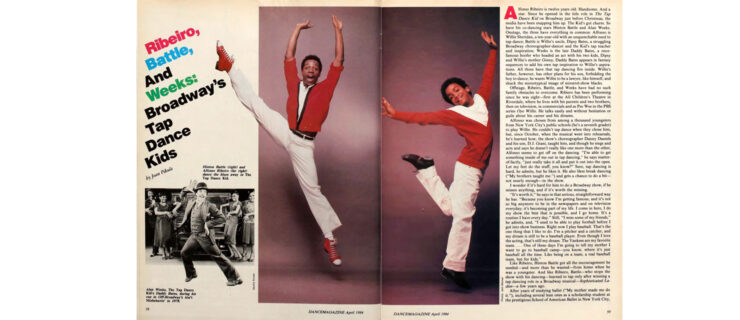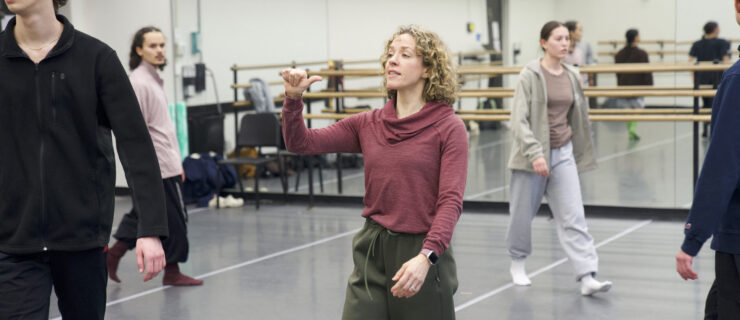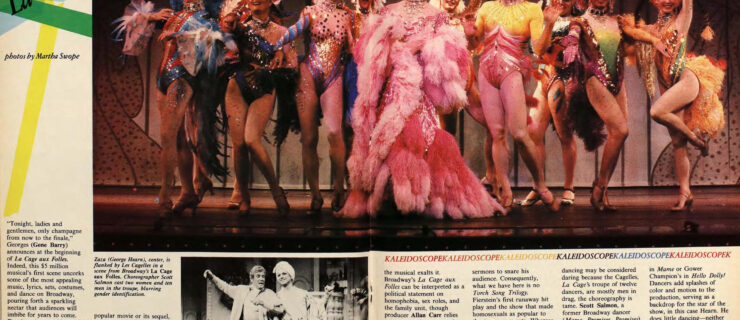Mis-Direction
Let’s face it: We’ve all seen bad choreography, often from the inside out. What makes it bad can be any combination of elements: shabby construction, a disconnect with the music, thematic or movement clichés, ugly and/or restrictive costumes, poor lighting, lack of direction, even danger to the performers themselves. In some cases, a piece might not necessarily be poorly made, but it doesn’t resonate—maybe it’s boring or difficult to perform. The question, then, is not whether bad or unlikeable choreography exists, but what can dancers do about it?
How Bad Is It?
Not surprisingly, when most dancers talk about bad choreography, they are reluctant to name specific names. The dance community is relatively small, after all, and nobody wants to alienate past or potential employers. That said, some of the dancers we spoke with were willing to talk about the work itself, if not its creators. Evan Knapp, a retired dancer who performed with Radio City Music Hall, Isaacs/ McCaleb & Dancers, and others, recalled one particularly egregious experience performing “a whole piece to Johnny Mathis. It had a cheesy narrative and ’70s costumes. I didn’t invite people to the show.”
Les Ballets Trockadero company member Raffaele Morra said that when he performed with a contemporary company in his native Italy, he sometimes had to dance “less-interesting choreographies of less-known choreographers that, with the idea of making something new and avant- garde, were actually just putting together steps not really connected one to the other.” In particular, Morra, whose stage name veers between Lariska Dumbchenko and Pepe Dufka, remembers work by a young Italian choreographer in which the dancers performed under cones of light meant to symbolize the restrictions of day-to-day living. “This idea was already depressing, but on top of it, the music was not helping and the costumes, made of a black trash-bag lookalike fabric, were really not appealing,” he said. “All the dancers were complaining about how bad the production was, how the choreography was not interesting.”
Brooklyn-based dancer Rosalynde LeBlanc, who has performed with Bill T. Jones/Arnie Zane, White Oak Project, Metropolitan Opera, and most recently OtherShore, said there have been two cases where she felt the work she was dancing was truly bad. In one, the choreographer didn’t seem to have done his homework and wasn’t prepared for the size and scale of the piece, so he leaned heavily on the dancers to provide the magic. In the other, the choreographer actually put the dancers’ safety at risk. “I couldn’t perform in the way I have always performed, where you throw out all the negativity and the judgments and execute the work confidently and wholeheartedly,” LeBlanc said. “I couldn’t pretend I wasn’t afraid—I had to perform the fear. Luckily, nothing bad happened and I learned a lot.”
Martha Butler-Long, a Houston Ballet and American Ballet Theatre veteran, experienced something similar once when she had to dance perched on a rather intimidating moving structure. “If you liked living on the edge, you were on top,” she said. In another case, she tore the ligaments in her ankle during a section that the choreographer later amended. “Usually, the steps become part of your body, so you can let the artistry come out,” she said. “When it’s bad, you can’t do that, which is kind of aggravating.”
As these dancers pointed out, however, sometimes the work isn’t bad per se—it’s just not your thing. LeBlanc said that, at least in one case, it wasn’t necessarily the fault of the choreographer.
“It’s not that the movement was bad, it was more that it didn’t move me or speak to me or make sense to me,” she said. “But if it’s not my aesthetic, it’s because we’re two different people. I understand from the choreographer’s perspective that they’ve invested all this time and money in the work.”
Do We Have To?
Can dancing bad work be avoided? All the dancers we spoke with said no. “It happens a lot,” said Knapp. “Everything you do can’t be fantastic. I just figured I’m a dancer—it’s my job.” Butler-Long, who is now rehearsal assistant for Sandra Organ Dance Company in Houston, agreed: “You’re there to entertain,” she said.
“Performing in choreography you don’t connect to happens more often than you think,” said LeBlanc. “With Bill T., his vision and voice and aesthetic were the most connected to mine. It never occurred to me that it wouldn’t happen again. It has, but it’s rare—probably for most dancers it’s rare.” That’s something she has tried to convey as a teacher when her students don’t like the phrase or structures she gives them.
“You can almost pinpoint the ones who will become successful dancers and who will fall by the wayside by how they cope,” she said. “If they think they’ll be doing work they like for the rest of their lives, they’re sadly mistaken.”
Coping Strategies
So how do people cope? Knapp remembered planning his breaks (“Do I have time to get some soup from Au Bon Pain?”) between matinee and evening shows. Butler-Long once painted her toenails a different color for each performance, a little secret that put a smile on her face. “Nobody could see my feet, because they were in pointe shoes, but that kind of helped me,” she said.
Morra said he tried to cooperate with the aforementioned Italian choreographer, all the while “praying that maybe the ballet was going to be a flop and I would not have to dance it too many times. Luckily, that’s exactly what happened: We performed it only twice since the public didn’t like it at all. At the end, though, I was happy that I had experienced something different. The choreography was bad, but some of the movements turned out to be helpful with my future experiences. I had learned something good!”
Ballet British Columbia dancer Melissa Morrissey, who has done a lot of freelance work, has had similar experiences. “It always depends on the circumstance,” she said. “There are certain movements that don’t suit certain bodies or styles, so it’s a challenge to make it work. I try to find the positive side to most situations. I’ve had fun with the other dancers, even when the piece is bad. Sometimes I didn’t like something but the audience loved it, so that flipped it. And sometimes it’s great when the choreographer is pushing you to explore your body and see how far you can push yourself.”
As everyone pointed out, the dancers are the ones in the spotlight, so the burden of the audience’s expectations tends to fall on them. That means it behooves performers to find something redeeming in the work. “It’s all part of the game,” LeBlanc said. “The dancer’s skill is holding the choreographer’s thoughts responsibly and delivering the work fully and wholeheartedly. You have to bring yourself to it with dignity.” That also goes for cases when one’s colleagues are similarly unenthused. “I try to lead by example and hope it trickles down,” she said. “It’s a more constructive way to deal with it.”
And she agreed with Morrissey that pieces you don’t love can push you. “From those I learn more,” she said. “If it’s hard and I feel I don’t look ‘good’ in it, I have to bring myself up to the challenge. The effort to find a way to do something I don’t like is a sharper learning curve, and it’s made me a stronger dancer.”
“That’s a really nice way to look at it,” Butler-Long said later with an admiring chuckle, “although I think there are more interesting ways to become a better dancer.” She conceded, however, that bad work does test a dancer’s skills, and she always managed to get through it. “I would give myself a pep talk,” she said. “Once you’re out there, it’s not so bad. Sometimes the rehearsals are worse. And in dull ballets, everyone is there with you in the dread.”
Just Say No
Sometimes, when things are really bad—especially when they’re dangerously bad—it pays to voice your concerns. “I’m pretty vocal, so I speak up,” said Butler-Long. “When you have a nice, close relationship with the choreographer, they can read it on your body, anyway.”
The first time Morra worked with the Italian choreographer, he was younger; the second time, he had more experience and was less afraid to speak out. “Many of the younger dancers of the company accepted the idea they had to dance in this production,” he said. “I tried again, but halfway through the process, I had to talk to the director of the company and he finally withdrew me from the ballet. He understood that the ballet was not good, but more important, he understood I was not good for it. My style was not appropriate and I would have made it look bad and vice versa.”
And sometimes, it’s best just to move on. When Morra discovered that his company would be working with that particular choreographer again, he handed his director a letter of resignation. “I started to look for a job that suited me better,” he said. “I found the Trocks. With the Trocks I am lucky to dance all the classical ballet repertory that I love.”
Not everyone finds such a happy ending, but dancers have always dealt with bad choreography in one way or another. And every once in a while, bad choreography can mean the beginning of something new. Next time it happens, consider your options—what can you do to make it work for you?
Heather Wisner, managing editor of Make-up Artist Magazine, is a former Dance Magazine associate editor now based in Portland, OR.




